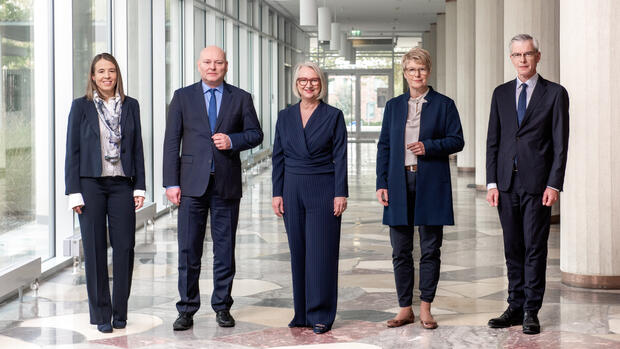Ulrike Malmendier (from left), Achim Truger, Monika Schnitzer, Veronika Grimm and Martin Werding let the air out of the IRA panic.
(Photo: Economic Advisory Council)
Berlin According to the business wise men, the huge subsidies in the USA for low-emission technologies will not lead to a massive exodus of European companies to the United States.
The German Council of Economic Experts estimates the consequences of the Inflation Reduction Act (IRA), which will cost around 370 billion dollars, for Europe “as rather small overall”. This emerges from a “Policy Brief” published by the economic experts on Friday. It is a new format of economics.
“For individual branches of industry, the subsidies from the IRA could increase the attractiveness of the USA as a location and thus increase the incentive to invest in the USA instead of in the EU,” it said at the same time. However: The economists warn of the significantly lower energy prices in the USA. They see this as a much greater threat to the European location.
The IRA only plays a supporting role. The German Council of Economic Experts expects the electricity prices in the USA to drop by around one cent per kilowatt hour over the next ten years. The difference between electricity prices in the USA and in Germany will average around 6.6 cents per kilowatt hour by 2030.
In order to strengthen the competitiveness of European companies, additional subsidies are also being demanded in the EU in response to the US subsidy package.
>> Read also: What Industries the IRA Really Hurts
A subsidy race triggered by the IRA would be associated with considerable “welfare losses” for both the USA and the EU and should therefore be avoided, the economists warn. They also warn against national programs as a response that could trigger a “bidding war” within Europe.
It is conceivable that the IRA will end up being significantly larger than previously thought. Because announced tax credits are not capped, the 370 billion could be significantly higher. The economists consider it possible that the funding volume will ultimately be double or triple the previous estimate.
TTIP relaunch brought into play
According to the information, the EU is already promoting low-emission technologies with the Green Deal Industrial Plan to a comparable extent as the USA. However, the tax breaks of the IRA program for companies are much easier to plan and are not capped in the event of production expansions.
Ulrike Malmendier suggests that the existing European subsidy programs could be examined to see how the subsidy programs can be made easier for companies. “At the same time, the funding should be geared more towards the expected reduction in emissions from the funded activities.”
In order to reduce energy costs, the supply of electricity and the energy infrastructure should be expanded quickly. To do this, the expansion of renewable energies would have to be accelerated and hydrogen-capable gas-fired power plants built in Germany.
The tax credits in the IRA are particularly high if a large proportion of the raw materials and intermediate products used come from the USA or from countries with which the USA has free trade agreements.
In order to benefit more from the IRA, but also to strengthen the investment locations in global competition, the economists propose a free trade agreement with the USA. The EU should press ahead with the negotiations for this.
>> Read also: How the Council of Experts is repositioning itself
A few weeks ago, the Vice President of the EU Commission, Valdis Dombrovskis, made a proposal of this kind. He brought up a trade agreement for climate-friendly technologies. The EU could try to explore the possibility of mutual market opening for the first time after the failed negotiations on the transatlantic free trade area TTIP in 2017.
With agency material.
More: Why the USA is overtaking the Europeans in AI investments

